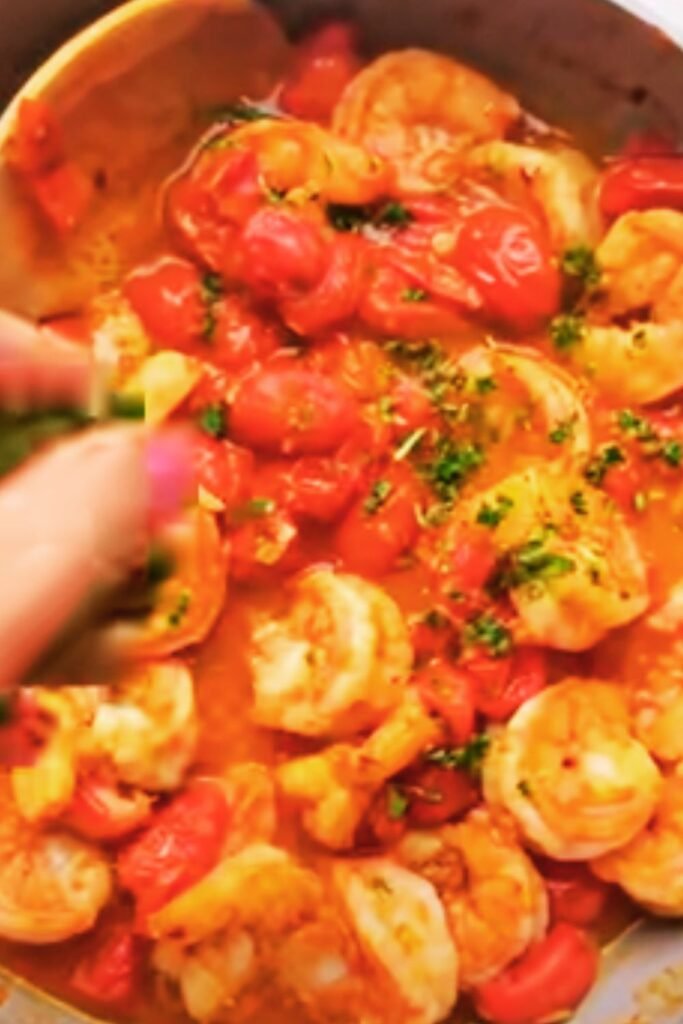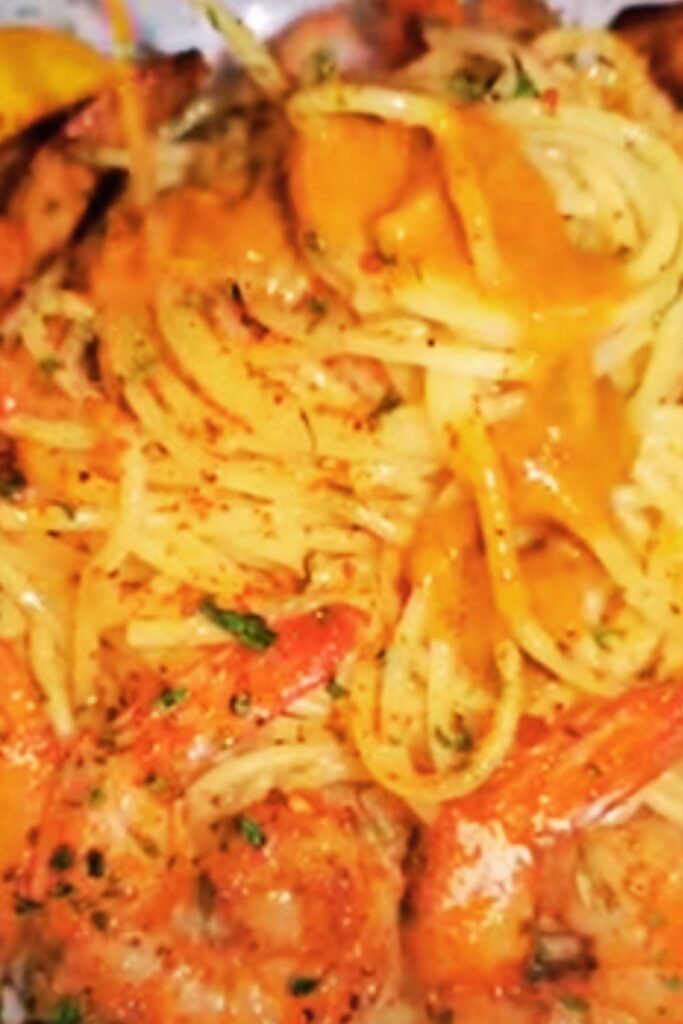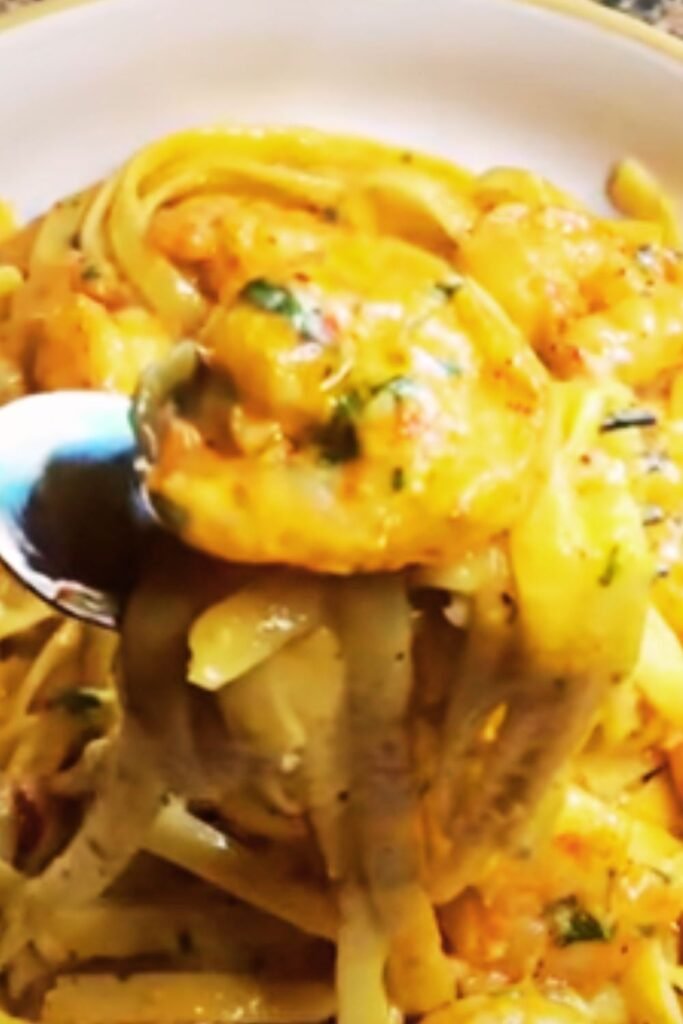There’s something magical about fusion cuisine that makes my heart sing and taste buds dance. Today, I’m sharing one of my absolute favorite culinary mashups: Cajun BBQ Shrimp Scampi Linguine. This dish marries the bold, spicy flavors of the Louisiana bayou with the garlicky, buttery goodness of Italian scampi, all twirled together with perfect al dente linguine. It’s a match made in food heaven that I discovered during a memorable cooking adventure with friends from New Orleans and Sicily.
The beauty of this dish lies in its surprising harmony. The smoky, spicy Cajun seasonings complement the classic garlic-butter sauce in ways that will make you wonder why this combination isn’t more common. When you add plump, succulent shrimp to the mix, you’ve got a plate of pasta that’s guaranteed to impress even the most discerning food enthusiasts.
The Unexpected Origin Story
My journey with this recipe began five years ago during a summer thunderstorm when I had planned to grill shrimp outdoors. Mother Nature had other ideas, forcing me to pivot to an indoor cooking method. With Italian linguine already boiling and Cajun spices at hand for the original BBQ plan, I took a chance on combining these seemingly disparate culinary traditions. The result was so mind-blowingly delicious that it has become my signature dish for dinner parties and special occasions.
What makes this recipe truly special is how it transforms ordinary ingredients into something extraordinary. The depth of flavor comes from building layers—starting with a foundation of aromatic vegetables, adding complexity with smoked paprika and Cajun spices, enriching with butter and white wine, and finishing with a touch of acidity from fresh lemon. The result is a pasta dish that’s simultaneously comforting and exciting.
Essential Ingredients: The Building Blocks of Flavor
Before diving into the cooking process, let’s talk about the key players that make this dish sing:
- Shrimp: I recommend large or jumbo shrimp (16-20 count per pound) for the best texture and presentation. Fresh is ideal, but high-quality frozen shrimp work well too—just thaw them properly.
- Cajun Seasoning: The soul of this dish. While store-bought blends work fine, I’ve included my homemade mix below for those who want maximum flavor control.
- Linguine: This flat, medium-width pasta is perfect for catching the sauce. The slight chewiness provides an excellent contrast to the tender shrimp.
- Butter and Olive Oil Combination: Using both gives you the best of both worlds—flavor from the butter and a higher smoke point from the oil.
- Fresh Garlic: Non-negotiable. Pre-minced won’t deliver the same punch of flavor.
- White Wine: Adds acidity and depth. A dry Pinot Grigio or Sauvignon Blanc works beautifully.
- Lemon: Both the juice and zest brighten the entire dish.
- The Holy Trinity: Onion, bell pepper, and celery—the foundation of Cajun cooking.
- Fresh Herbs: Parsley adds color and freshness, while thyme contributes earthy notes.

Homemade Cajun Seasoning Blend
While store-bought Cajun seasoning works in a pinch, nothing beats homemade for freshness and customized heat levels. Here’s my go-to blend that perfectly balances heat, smokiness, and herbaceous notes:
| Ingredient | Amount | Flavor Contribution |
|---|---|---|
| Paprika | 2 Tbsp | Earthy, sweet base note |
| Smoked Paprika | 1 Tbsp | Smoky depth (BBQ element) |
| Garlic Powder | 1 Tbsp | Savory foundation |
| Onion Powder | 1 Tbsp | Sweet aromatic base |
| Dried Oregano | 2 tsp | Mediterranean herbal notes |
| Dried Thyme | 2 tsp | Earthy, slightly floral component |
| Cayenne Pepper | 1-2 tsp | Heat (adjust to preference) |
| Black Pepper | 1 Tbsp | Sharp spice |
| White Pepper | 1 tsp | Subtle, complex heat |
| Salt | 1 Tbsp | Flavor enhancer |
Mix all ingredients thoroughly and store in an airtight container for up to three months. This blend will make more than you need for one pasta dish, but trust me, you’ll find plenty of uses for it.
The Perfect Shrimp: Selection and Preparation
The star of this show deserves special attention. Here’s how to ensure your shrimp shine:
Selecting Shrimp:
- Size: 16-20 count per pound (jumbo) or 21-25 count (large)
- Fresh or frozen: If frozen, look for “individually quick frozen” (IQF) with no added preservatives
- Shell status: Shell-on shrimp have more flavor, but peeled and deveined save prep time
- Wild-caught vs. farm-raised: Wild American shrimp have superior flavor but sustainable farm-raised options are good alternatives
Proper Thawing Technique:
Never thaw shrimp under hot water or in the microwave! These methods partially cook the shrimp and result in a rubbery texture. Instead:
- Place frozen shrimp in a colander
- Set the colander in a large bowl
- Run cold water over the shrimp for 5-7 minutes, tossing occasionally
- Alternatively, place in refrigerator overnight on a plate with paper towels beneath
Prep Steps:
- Pat thawed shrimp completely dry with paper towels (crucial for proper searing)
- If shell-on, remove shells but consider saving them to make seafood stock for future use
- Devein by making a shallow cut along the back and removing the dark intestinal tract
- Season with a light sprinkle of salt and a portion of your Cajun seasoning
Complete Recipe: Cajun BBQ Shrimp Scampi Linguine
Now that we’ve covered the foundational elements, let’s dive into the full recipe that serves 4-6 people:
Ingredients:
For the Pasta:
- 1 pound (16 oz) linguine pasta
- 2 tablespoons kosher salt (for pasta water)
For the Cajun BBQ Shrimp:
- 2 pounds large shrimp, peeled and deveined
- 3 tablespoons Cajun seasoning (divided use)
- 4 tablespoons unsalted butter
- 3 tablespoons olive oil
- 1 medium yellow onion, finely diced
- 1 red bell pepper, finely diced
- 2 celery stalks, finely diced
- 6 cloves garlic, minced
- 1 teaspoon smoked paprika
- ¼ teaspoon cayenne pepper (optional, for extra heat)
- ½ cup dry white wine
- 3 tablespoons fresh lemon juice
- 1 tablespoon lemon zest
- ¼ cup fresh parsley, chopped
- 1 tablespoon fresh thyme leaves
- ¼ teaspoon freshly ground black pepper
- ½ cup reserved pasta water
Instructions:
Step 1: Prepare the Pasta
- Bring a large pot of water to a rolling boil
- Add 2 tablespoons kosher salt (the water should taste like the sea)
- Add linguine and cook according to package directions until al dente (usually 9-11 minutes)
- Before draining, reserve ½ cup of the starchy pasta water
- Drain pasta but do not rinse
Step 2: Prepare the Shrimp
- Pat shrimp dry with paper towels
- Toss with 2 tablespoons of Cajun seasoning until evenly coated
- Let sit at room temperature for 10-15 minutes (but no longer than 20)
Step 3: Create the Flavor Base
- In a large, heavy-bottomed skillet or sauté pan, heat 2 tablespoons olive oil over medium heat
- Add the “holy trinity” (onions, bell peppers, and celery) and sauté for 3-4 minutes until softened
- Add minced garlic and cook for another 30 seconds until fragrant (be careful not to burn)
- Stir in smoked paprika and remaining Cajun seasoning, toasting the spices for about 30 seconds
Step 4: Cook the Shrimp and Create the Sauce
- Increase heat to medium-high and add 1 tablespoon olive oil
- Add seasoned shrimp to the pan in a single layer (work in batches if necessary to avoid overcrowding)
- Sear for 2 minutes on one side until slightly caramelized
- Flip shrimp and cook for another 1-2 minutes until just pink and opaque
- Remove shrimp to a plate and set aside temporarily
- Reduce heat to medium and add white wine to deglaze the pan, scraping up all the flavorful brown bits
- Simmer wine until reduced by half (about 2-3 minutes)
- Add butter and swirl until melted and beginning to foam
- Return shrimp to the pan along with any accumulated juices
- Add lemon juice, lemon zest, and most of the fresh herbs (reserve some for garnish)
- Toss gently to combine
Step 5: Combine and Finish
- Add drained linguine directly to the sauce pan
- Drizzle in reserved pasta water a little at a time while tossing continuously (this creates a silky sauce)
- Continue tossing until pasta is well coated and sauce has thickened slightly
- Taste and adjust seasoning if needed
- Remove from heat and let rest for 1-2 minutes before serving

Serving Suggestions:
This showstopper deserves proper presentation. Here’s how I like to serve it:
- Use warmed plates to keep the pasta hot longer
- Twirl the linguine into a neat mound using tongs and a large spoon
- Arrange shrimp decoratively on top and around the pasta
- Sprinkle with reserved fresh herbs
- Add a lemon wedge on the side for those who enjoy extra citrus brightness
- For a complete meal, serve with:
- A simple mixed green salad with vinaigrette
- Crusty garlic bread for sopping up the incredible sauce
- Sparkling water with lemon or lime
Troubleshooting Common Issues
Even experienced cooks encounter challenges occasionally. Here are solutions to potential problems:
Dry or Overcooked Shrimp
- Problem: Shrimp are rubbery or tough
- Solution: Remember that shrimp cook incredibly quickly. They’re done when they just turn pink and opaque. When in doubt, undercook slightly as they’ll continue cooking in the hot sauce.
Watery Sauce
- Problem: Sauce isn’t clinging to the pasta
- Solution: Make sure you’re using the starchy pasta water and allowing enough reduction time. If still too thin, remove the pasta and shrimp, increase heat, and reduce sauce further before recombining.
Bland Flavor
- Problem: Dish lacks punch despite seasonings
- Solution: Season in layers throughout cooking. Don’t forget acid (lemon) and salt, which brighten flavors. Also, toast your spices properly to release their full potential.
Gummy Pasta
- Problem: Linguine is sticky or overcooked
- Solution: Cook pasta exactly to al dente—it should offer slight resistance when bitten. Adding olive oil to pasta water is unnecessary; instead, toss drained pasta with a touch of oil if not adding to sauce immediately.
Make-Ahead and Storage Tips
While this dish is best enjoyed fresh, life sometimes requires planning ahead:
Make-Ahead Options:
- Prepare Cajun seasoning up to 3 months in advance
- Chop all vegetables and store in refrigerator up to 24 hours in advance
- Clean and season shrimp up to 8 hours ahead (keep refrigerated)
Proper Storage:
- Refrigerate leftovers in an airtight container for up to 2 days
- Reheat gently in a skillet with a splash of water or white wine
- Freezing is not recommended as the texture of both shrimp and pasta deteriorates
Health and Dietary Adaptations
This recipe can be modified to accommodate various dietary needs without sacrificing flavor:
Gluten-Free:
- Substitute regular linguine with gluten-free pasta made from rice, corn, or chickpea flour
- Ensure your Cajun seasoning contains no gluten (some commercial blends include anti-caking agents with gluten)
Lower-Calorie:
- Reduce butter to 2 tablespoons and increase olive oil proportion
- Use half the amount of pasta and double the vegetables
Dairy-Free:
- Replace butter with additional olive oil or a high-quality dairy-free butter alternative
- Add a tablespoon of nutritional yeast for savory depth

The Science Behind the Magic
Understanding the culinary science at work helps you become a better cook. Here’s what’s happening beneath the surface:
The Maillard Reaction:
When searing shrimp at high heat, you’re initiating the Maillard reaction—a chemical reaction between amino acids and reducing sugars that gives browned food its distinctive flavor. This is why properly searing (rather than steaming) shrimp is crucial for developing deep flavor.
Emulsification:
The silky sauce results from proper emulsification—suspending tiny droplets of fat (butter) within the water-based elements (wine, lemon juice, pasta water). The starchy pasta water contains natural emulsifiers that help stabilize this mixture, creating a smooth, cohesive sauce that clings beautifully to the pasta.
Flavor Development:
Blooming spices in oil releases fat-soluble flavor compounds that would remain locked away in dry applications. This is why we toast the Cajun seasonings briefly in oil before adding liquid components.
Creative Variations to Explore
Once you’ve mastered the base recipe, try these exciting variations:
Protein Swaps:
- Chicken: Use boneless, skinless chicken thighs cut into bite-sized pieces
- Andouille Sausage: Add sliced sausage for an even more authentic Cajun touch
- Seafood Medley: Combine shrimp with scallops, mussels, and chunks of firm white fish
Vegetable Additions:
- Charred Corn: Add kernels cut from a grilled cob for sweet smokiness
- Fire-Roasted Tomatoes: Stir in a half cup for acidity and color
- Sautéed Mushrooms: Add cremini or oyster mushrooms for earthy depth
Pasta Alternatives:
- Zucchini Noodles: For a low-carb option
- Fettuccine: For a heartier bite
- Orzo: For a risotto-like texture
Q&A Section
Q: Can I make this dish less spicy while still maintaining the Cajun character?
A: Absolutely! The heat in this dish comes primarily from the cayenne pepper in the Cajun seasoning. When making your own blend, simply reduce or omit the cayenne and use less of the overall seasoning on the shrimp. The smoked paprika will still provide that signature BBQ flavor without the heat.
Q: I don’t consume alcohol. What can I substitute for the white wine?
A: You can replace the wine with chicken or seafood stock plus 1 tablespoon of fresh lemon juice or white wine vinegar. This will provide similar acidity and depth. For additional complexity, add a teaspoon of honey to balance the acidity.
Q: Can I use pre-cooked shrimp to save time?
A: While fresh shrimp deliver the best flavor and texture, you can use pre-cooked shrimp in a pinch. If doing so, add them at the very end of cooking, just long enough to warm through (about 1 minute). Over-heating pre-cooked shrimp will make them tough and rubbery.
Q: How do I know when the shrimp are perfectly cooked?
A: Perfectly cooked shrimp form a loose “C” shape and are opaque with a pearly pink color. If they curl into a tight “O” shape, they’re overcooked. Remember that shrimp continue cooking slightly after being removed from heat due to residual heat, so it’s better to remove them from the pan when they’re just shy of done.
Q: My sauce separated and looks oily. How can I fix this?
A: This typically happens when the sauce is overheated or the butter is added too quickly. To rescue a broken sauce, take the pan off the heat and whisk in 1-2 tablespoons of cold pasta water while stirring vigorously. You can also blend a small portion of the sauce with an immersion blender to re-emulsify it before combining with the rest.
Q: Can I prepare this dish for a larger crowd?
A: This recipe scales well for larger gatherings. For 8-10 servings, simply double all ingredients and cook in batches to avoid overcrowding the pan. You may need two separate pans for the final combining step, or use a large dutch oven or stock pot.
Final Thoughts
What I love most about this Cajun BBQ Shrimp Scampi Linguine is how it represents the very best of fusion cuisine—taking beloved elements from different culinary traditions and creating something that honors both while becoming entirely its own. The dish delivers complex flavors and impressive presentation while remaining accessible to home cooks.
Remember that cooking is as much about feeling and intuition as it is about following instructions. Use this recipe as a foundation, but don’t be afraid to adjust seasonings to suit your taste, swap ingredients based on what’s fresh and available, or add your own creative touches. That’s how great recipes evolve and how we grow as cooks.
Every time I serve this dish, I’m reminded of how food brings people together across cultural boundaries. There’s something deeply satisfying about watching friends and family fall silent for that first perfect bite, then burst into animated conversation about the flavors they’re experiencing. That moment of connection—that’s what cooking is all about.
So heat up your skillet, pour yourself something refreshing, and prepare to create a meal that might just become your new signature dish too.


